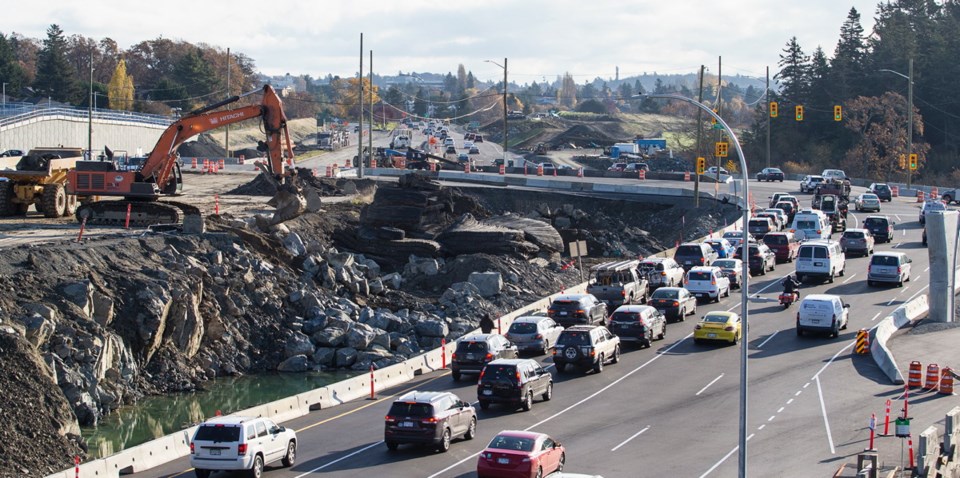A six-month delay has been announced for the McKenzie interchange project, pushing its wrap-up to summer 2020 rather than the end of this year.
“Our revised schedule is to have free-flow traffic on Highway 1 by winter and the overall project completed by the summer of 2020,” said Janelle Staite, regional deputy director for the Ministry of Transportation, as she stood next to the work site on Friday. “We’ll have the traffic signals eliminated on Highway 1 in the winter, which means we have the bridge completed, the traffic is free-flowing underneath the bridge and we’ll also have our dual right turn from McKenzie onto the highway going north.”
Finishing touches after that will include landscaping and adding transit access. The Galloping Goose section of the project has been in place for about a year.
“And we’ll also be finalizing the loop ramp, or the clover-leaf ramp,” Staite said. “So that’s where that heavy volume of about 30 per cent of the traffic is heading off of the highway and heading up McKenzie Avenue.”
The delay will mean an undetermined cost increase for the project, which currently has a budget of $85 million.
“Right now, we’re about 55 per cent complete,” Staite said. “Our hope had been that by the end of the summer we would have free-flow traffic on Highway 1 and we would have the overall project complete by the end of 2019.”
This is the second time the completion date has moved — the first hoped-for completion was sometime in 2018.
The earlier delay was caused in part by a need to adjust the work schedule to lessen noise and impact on traffic flow. This time, concerns with rock formations and a snowy winter have combined to move the timeline back, Staite said.
Work started in September 2016 on the interchange. About 85,000 vehicles travel through the area daily.
Much of the work at present is related to the bridge, which will overarch the highway and connect Admirals Road with McKenzie Avenue.
“It’s doing what we affectionately refer to as the Big Dig,” Staite said. “We’re actually lowering Highway 1 about eight metres so the structure will go over top of it and Highway 1 traffic will go underneath.”
In doing the excavation, workers recently came across unforeseen issues, she said.
“We do a lot of drilling and testing to understand our soil conditions and our rock conditions in advance of a project, but when we went to actually drill the piles for the centre pier, we encountered rock much earlier than we’d anticipated.”
The rock also has a variable surface level, which creates difficulties.
She said that has meant a new approach with more labour-intensive construction, and a setback of up to eight weeks.
“On top of that engineering challenge we had with the rock horizon, everybody in the CRD area knows that this past February we were hit with record snowfall,” Staite said. “That snowfall in any construction site slows us down to a halt.
“We can’t work when the site’s covered in many inches of snow, and we have to wait until that snow is cleared to be able to get up and running again.”
She said the added cost for the project is unknown at this point.
“Right now we’re working with the contractor to understand what it means from a cost perspective,” Staite said.
She said more should be known in about a month.
Staite acknowledged that some people will be disappointed with the revised project schedule.
“We appreciate the fact that it is frustrating for folks that there is a delay on the project,” she said. “We know there’s going to be upward of 20-minute travel-time savings for commuters, so it’s that short-term pain but that significant long-term gain that’s going to give people an opportunity in the mornings and the afternoons to have a more reliable and more efficient commute.”



